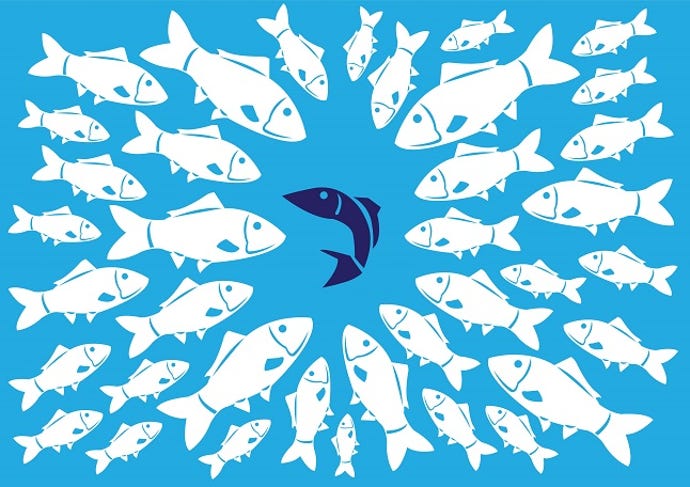

Collaboration Versus Groupthink: How to Tell the Difference
source link: https://www.informationweek.com/strategic-cio/collaboration-versus-groupthink-how-to-tell-the-difference
Go to the source link to view the article. You can view the picture content, updated content and better typesetting reading experience. If the link is broken, please click the button below to view the snapshot at that time.
Collaboration Versus Groupthink: How to Tell the Difference

Effective IT collaboration requires many things, including the ability to work as a congenial, unified team. But what happens when a team becomes so unified that consensus becomes groupthink?
Groupthink can be both subtle and dangerous. There's almost always a tendency for members to agree with the rest of the team, says Ola Chowning, a partner with technology research and advisory firm ISG. “This is certainly the path of less resistance -- it takes less courage, less effort, less time.”
Unfettered groupthink can lead to everyone nodding, holding hands, and marching in happy unison right up to and over the edge of the cliff. “Just because everyone appears to agree does not automatically result in the idea or approach being successful,” Chowning explains. Indeed, groups will often convince themselves of their invincibility based entirely on the power of numbers. “It causes the team to ignore data or even their own worry about potential failure,” she says.
Setting Goals
Anita Williams Woolley, an associate professor of organizational behavior and theory at Carnegie Mellon University's Tepper School of Business, says it's vital for teams to reach clarity and alignment on each goal. “Otherwise, someone might suggest a solution that ‘sounds good,’ and the group goes with it, even if it’s a mismatch with what some thought the problem was to begin with,” she notes.

Anita Williams Woolley, Carnegie Mellon
Once the project's goals have been clearly established, the team can begin developing potential ideas and/or solutions. It's important to begin with a phase where team members develop ideas independently, and that they do so before they hear what others think, especially before they hear what the leader thinks, Woolley advises. “The research on brainstorming and creativity is very clear, that independence of thinking and unique ideas are quickly lost if the group starts sharing ideas right away,” she explains.
Warning Signs
Alarms should sound and red flags should wave when there's no disagreement among team members. “That's a really bad sign unless it's the resolution of previous disagreement,” says Amie Devero, president of Beyond Better Strategy and Coaching. When people buy into groupthink, they give up their creativity and individuality. “When there's no pushback, no alternatives, no grumpy nay-saying, the odds are that groupthink is present,” she says.
A team leader who is forceful and opinionated, or who disregards counter opinions, can inadvertently encourage groupthink, Chowning says. Teams lacking diversity in their general makeup -- limited to members with similar backgrounds and perspectives -- are also at risk of falling into groupthink, she notes.
Effective Approaches to Encourage Expression
A project leader can encourage free expression by advocating ideas and critical thinking in a non-biased way. “One method is to require each team member to submit their own best idea and then have the group vote on a certain number to take forward,” Chowning suggests. “Next, require the team to scrutinize each idea.”
Chowning also recommends using an around-the-room method known as the “DAISIE” chain, an acronym for Disagree, Agree, Improve, Simplify, Implode (present a negative outcome or result) and Exchange (offer a new idea or approach). “Each team member in a chain is required to take the next position,” she explains. “At the end of the chain, a simple democratic vote is often used to pick the best idea(s) to move forward with.”
Carnegie Mellon’s Woolley suggests asking the following questions to help keep discussions on track:
- What is the problem we are solving?
- Do we all agree on the outcomes we are targeting?
- Are those the right or best outcomes?
- Is the solution we are pursuing the best way to achieve those outcomes?
- What else might go wrong?
Goodbye, Groupthink
The key point to remember is that kneejerk positivity is a problem, Devero says. “A competition of ideas, healthy disagreements, and debate about which is best creates better ideas.”
Groupthink is a disease of charisma and, sometimes, of a lack of psychological safety, Devero notes. “If the leader bristles when her ideas are contradicted, or the group thinks they will get penalized for being ‘negative’, groupthink will be the order of the day,” she says. “Fostering both disagreement and the psychological safety to be at creative odds is an important component of building highly imaginative and effective teams.”
What to Read Next:
Introducing the Two-Minute Toolkit Podcast
Recommend
About Joyk
Aggregate valuable and interesting links.
Joyk means Joy of geeK